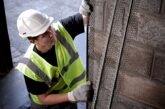
Roger Bisby visits a new seven-star hotel to check out the new plastering technique being employed there.
Knauf has had an unenviable task in the UK – trying to take on British Gypsum with trowel-applied traditional plasters was always going to be a difficult task, but the company has certainly established itself with boards and has made good inroads with projection plastering.
But projection plastering is a specialist game more suited to the big contractors. Knauf’s airless spray plasterers are different. They can be delivered through spray plant that is routinely used for paint spraying and this has opened the market up significantly.
![]() The latest breakthrough has been the development of a lightweight finish that can be applied to smooth backing coats such as airless backing plaster or directly onto boards.
The latest breakthrough has been the development of a lightweight finish that can be applied to smooth backing coats such as airless backing plaster or directly onto boards.
The job I went to see was taking place at Trinity House; the old Port of London Authority headquarters is being converted into London’s first seven-star hotel.
I witnessed the whole system being applied by SPS and thought that this was probably the one and only time I will be in one of those bedrooms. Once they have a ticket price of £2,000 to £3,000 per night I am back to the Premier Inn.
However, I hope that whoever does end up occupying those rooms takes a few minutes to appreciate the exceptionally fine finish of the plaster ceiling as they lie in their luxury bed. Somehow I doubt it – people only ever notice imperfections and there were none – so they will never be writing about them on Trip Adviser.
The great thing about this plaster is that it can be used as an alternative to jointing compounds, so you can spray and tape the joints and, three or four hours later, go back to spray a coat over the whole wall or ceiling. It is possible to spray a single coat and achieve a reasonable finish, comparable with traditional taping and jointing finish.
But to avoid seeing those vertical joints grinning through in strong raking sunlight, a second coat applied a few hours later is advised. Even whilst doing this a time saving of 20 to 30 per cent can be achieved.
![]() Additional advantages with the product is that it comes ready-mixed, so you don’t need to arrange water supplies and everything you trowel off can be fed straight back into the hopper. The wasted material is negligible.
Additional advantages with the product is that it comes ready-mixed, so you don’t need to arrange water supplies and everything you trowel off can be fed straight back into the hopper. The wasted material is negligible.
Because this is an air dry product rather than a chemical set it won’t go off in the spray plant, so you don’t have to clean it through every night. Again, this saves a lot of clean up water and disposal problems.
In fact, it is worth saying that is not really plaster in the traditional sense, it is a mixture of polymers that have many of the qualities of paint, but doesn’t mist like paint and there is no over-spray.
I was a bit concerned about using my very expensive camera in a room where spraying was taking place but there wasn’t a trace on the camera, even when I got close in. The most remarkable thing I saw was the application of the joint filling coat on the ceiling.
It was applied from the ground to a 3.8 metre high ceiling, and not only did it fill the joint it didn’t slump. That is nothing short of amazing.
The big question now, for me at least, is whether this system will be taken up by the smaller contractor working on a single house. Given that the spray plant is standard paint spraying equipment there are no issues with affordability, or moving the machine from room to room.
My final thought is that it might even be a system that is taken up by decorators as well as plasterers but, rest assured, there is nothing about this product that puts it in a lesser league to gypsum plaster.
Our thanks to the featured contractor at Trinity House, Spray Plaster Specialists.
For more information on Spray Plaster Specialists visit www.sprayplastering.co.uk







